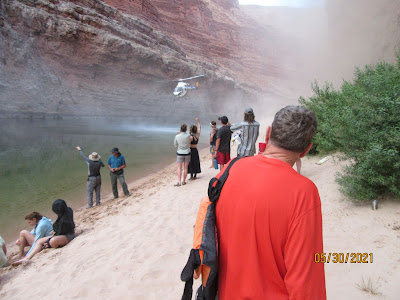We departed Flagstaff AZ, for a 2 hour plus bus trip to our departure point at Lee's Ferry. This is the very start of the Grand Canyon, where adventurous river runners launch their boats for trips down the canyon.
Those traveling across the country on Highway 89A between Bitter Springs and Jacob Lake, AZ arrive at two bridges similar in appearance spanning the Colorado River. These two bridges, one historic and one new, represent one of only seven land crossings of the Colorado River for 750 miles.
We finally arrive at Lee's Ferry our departure point. The two boats directly in front of of the orange life preservers belong to Canyoneers Grand Canyon Adventurers, our host for our 8-day journey
We all have our yellow day-bags which contain our personnel items for each day of our trip. Each night/morning we load items such as sun block, extra clothing, camera etc, for daily use. The bags are always available and secured each day.
We fit and adjusted our life preservers which must be worn at all times when in the raft. The canyon water temperature is between 46-50 degrees throughout our trip. The life preservers must be fitted properly in case someone would fall into the water. We would use the person to person hold and pull to assist lifting an individual from the water, If the preserver is not fitted properly, we would pull the person right out of the preserver.
Remember the bridges in the earlier photo, this is what they look like from below. The oldest bridge is called the Navajo Bridge. The Navajo Bridge served the area well for 66 years. However, as automobiles and trucks became larger, wider, and heavier, the need for a stronger, wider bridge became evident.
Ahead is Paria Riffle, mile one, our first look at white water. This is a very mild rapid. The rapids in the Grand Canyon are numbered 1-10. Ten being the most difficult to navigate by the pilot. The water level in the canyon is extremely low and very hazardous at this time.
The canyon walls are magnificent in both beauty and height. Nearly 40 identified rock layers form the Grand Canyon’s walls. The story of how Grand Canyon came to be begins with the formation of the layers and layers of rock that the canyon winds through. The story begins about 2 billion years ago.
When watching videos, click bottom right [ ] to expand video to full screen mode.
After successfully navigating House Wall Rapid, rated 9.8,7.7., we watch our sister raft encounter the rapid.
Kathy and I decided to sit up front to experience the rapids for ourselves. Yes, the water is damn cold!
Mile 20: We hiked one mile up-canyon, scrambling over boulders, to reach a stream where pools are carved into the slick rock. During times of plentiful precipitation, the stream transforms into water slides dropping into plunge pools.
Unfortunately, the water levels in the canyon were very low and we did not get a chance to experience the water slide.
Our first day in the canyon ended with a Medevac rescue of one of our members. There was not major medical event. Our Trip Leader determined he was not physically capable of proceeding. The Grand Canyon has on average 300 rescues per year.
The helicopter landed 10 feet from our projected tent site. All gear had to be relocated to ensure it was not blown away. We had dinner in the dark about 9 p.m. We slept without our tent the first night under the stars. Although the stars were unbelievable, neither of us slept well.
Note: Some of the date stamps on the photos are not correct. When you change the camera battery, you have to reset the date stamp. My mistake.
End of Day 1

















How amazing. I would have bet my house that you two would be up front.
ReplyDelete